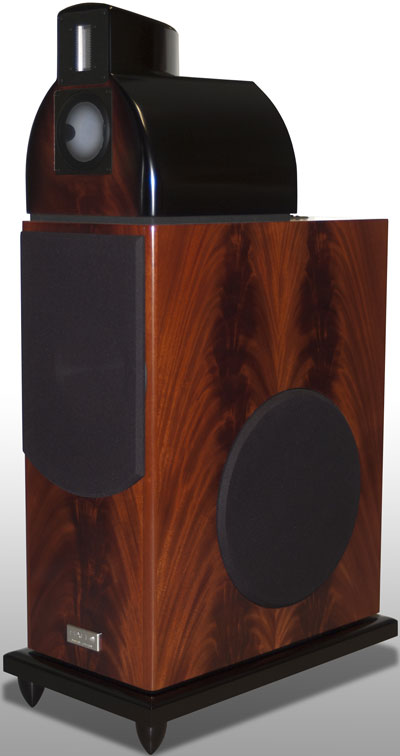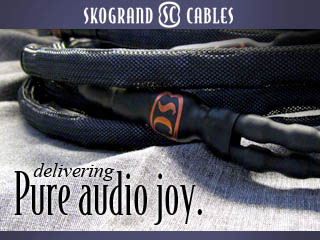Systems used in assessment
In describing the Soundscape 10’s sound I will first share about the systems used in assessment of the speakers. Though during the time I spent with the Soundscape 10 I assembled more than two systems, I mention these to give additional understanding in terms of my assessments when used with the associated equipment. Both systems used Clarity Cable Organic Digital, Interconnect, and Speaker cables, as well as Vortex Power Cords throughout. There is a tremendous amount of flexibility between these two systems, and I used all that flexibility in assessment of the Soundscape 10’s performance:
System 1: The “Minimalist Rig” was comprised of either the Simaudio Moon Evolution 750D or Denon 2900 Universal player as transport, and the Eastern Electric Minimax DAC Plus as sources. The Pathos Classic One MkIII Tube Hybrid Integrateds in mono mode provided amplification.
System 2: The “Full Blown” Rig used either of the two above sources, then moved to the VAC Signature Preamplifier MkII. Finally, either the VAC Phi200 amps in mono or the Pass Labs XA160.5 Monos, under review, were used.
These are by no means the extent of possibilities for system combination with the Soundscape speakers. One alternative which left a powerful impression was the Simaudio Moon Evolution 750D as source, into the VAC Signature MkII and Phi 200 monos with the Soundscape. Here I was in pursuit of the largest, most grandiose expression of the North American sound experience. The Evolution 750D has been without parallel in terms of palpability and the density of musical images, thanks in part to its massively overbuilt power supply, something quite unusual for a DAC/CD player. It is a perfect complement with the Salk speakers to ensure that there will never be heard a discouraging word – or note, for that matter – as there will never be stridency, irritating treble or mamby-pamby bass. You can pair these two and be fairly assured that if you seek a warmer, smooth and tonally rich result you will obtain it.
The speakers were positioned approximately four feet from the head wall and two feet from the side walls. I have many times placed speakers as close as 15-20” from the side walls, but it should be noted that my room has extremely solid construction and I would advise more distant placement with big speakers if one has standard 16” on center drywall, non-insulated walls. I typically toe in speakers to be aimed at my respective left or right ear and my seat is typically 12’ from the speaker’s front baffle, with approximately 8’ of space between the speakers.
Test music
I had begun my review of the Soundscape 10 anticipating that I would be attending C.E.S. 2012, so I culled some of my selections I have taken to shows in the past as demo tracks, thinking that I would have a fresh memory of the speaker to compare to the show setup. However, helping my ailing grandfather move closer to us took priority to the show. Nevertheless, the musical selections were valuable as they have been used with many speaker systems over the years, allowing me to gain a perspective of my impression of the Soundscape 10 in comparison to other speakers playing my demo music.
My test music ranges from John Rutter’s Prayer of St. Francis to the Counting Crows’ “Big Yellow Taxi,” to Mary Chapin Carpenter’s “I Am A Town” to Joe Satriani’s “I Just Wanna Rock.” Sometimes I use quiet solo flute or piano, while other times I may use largely synthesized music. One of the discs I rely upon regularly is the Natural Wonders Music Sampler 1997, which has a marvelous assortment of small ensemble and duet work with harp, flute, guitar and percussion instruments scattered throughout. My goal is typically to plum the extremes of a speaker and system’s performance, and that calls for a wide variety of music. My perspective is that a speaker made to be a manufacturer’s attempt at state of the art performance had better perform extremely well on all genres of music.
Newer recordings, even ones with copious compression such as Trombone Shorty’s Backatown, can be as instructive as older ones. One of my favorite samplers with a wide range of quality of recordings is The Best of Bond, which pulls together 30 plus years of movie title tracks. In that one disc is a wealth of demo material that allows one to hear how a speaker handles orchestration, rock, male and female vocals and more on older and newer recordings. Finally, recently I picked up Mandisa’s What If We Were Real, which is a contemporary Christian pop album. Mandisa backed Toby Mac, one of the very few Rap artists I will listen to. This disc is an infusion of upbeat, encouraging thoughts – contra much of the mental muck in mainstream media.
The softer side of the American speaker
Over the years American speakers have gained a reputation for big sound with an emphasis on scale and macrodynamics, often at the expense of finesse and tonality. I would like to say that the Soundscape 10 avoids that reputation completely, but it does not. In respect to the bass it follows traditional American speaker sound, while in the midrange and high end it leans toward nouveau speakers, the crop of less obtrusive towers with smallish drivers and ribbon tweeters.
One might say that the Soundscape 10 has a particular form of all-American bass performance. Construction on such speakers tends to be a very dense MDF with an attractive wood veneer, or if built to be more economical, an unfinished cabinet covered by grill cloth material. Three additional companies come to mind which would be representative as having this pattern; Vandersteen, Von Schweikert and Chapman Audio. I have owned and/or reviewed speakers from all these manufacturers. When it comes to low end response in a speaker they all are in a similar class.
There are, of course, differentiations easily heard, but in order to discuss their differences and how the Soundscape 10 compares I will utilize a simple scale with the sonic attribute of “Force” at one end and “Finesse” at the other. As all woofers and subwoofers have characteristics of varying degrees of force and finesse they can be placed along this continuum. I would suggest that all four brands of speakers mentioned lay further to the Force end of the continuum than the Finesse end.
For further clarification, I would regard “Force” to be subwoofer-like response, with prodigious output at lower frequencies, say from 30Hz down to 15Hz. “Finesse” is my subjective assessment of how clean and clear the bass is in listening comparisons, and I often check whether the speaker has tight specifications of +/- 3dB or better. It should be noted that this discussion relies upon general impressions of the Soundscape 10 to these other speakers, not direct comparison. I will discuss two speakers with which I did direct comparison and which fall more toward the Finesse end of the scale, the Legacy Audio Whisper DSW and the Daedalus Ulysses.
Rating these companies generally I would place all four brands to varying degrees at the Force end of the continuum. In other words, the cabinet, driver selection, crossover network, etc. of these speakers means they will have what is labeled typically as “prodigious” bass response, with a visceral or physical palpability to them – in other words a great deal of “force.”
They are not, however, the last word in terms of definition or Finesse in the bass. There are designs which have more innate definition, extracting superior resolution but not having the same degree of dynamic impact. Two of these are the Legacy Audio Whisper DSW and the Daedalus Ulysses. Note: Both the Whisper DSW and the Ulysses can be supplemented by sibling subwoofers. One might think the Whisper DSW would easily fall on the side of Force due to its having four 15” woofers per side, but those are open baffle woofers which lose the reinforcement of a closed cabinet design. The Daedalus Ulysses, currently under review, is a somewhat smaller speaker with less cabinet volume and somewhat conservatively sized bass drivers, so it will hit physical limitations on frequency extension relatively sooner. These two are, however, more clean and defined in the bass.
Do not conclude erroneously from this allocation of speakers that I find no merit in the design and performance of the Soundscape 10 or speakers like it. I am in subjective territory when making such distinctions, and a tremendous number of speaker makers and audiophiles feel that such Force speakers like these are in the sweet spot of transducer performance. For my preferences these are a bit on the thick/syrupy side, but absolutely defensible as one’s favorite expression of high end speaker performance.
Perhaps some listening sample descriptions are in order. Listening to “Sides of One” by Michelle Sell from Harpestry, I keyed in on the electric bass’s strong resonant tones. If I were to characterize the bass line as heard through the Souncscape 10, I would emphasize it was strong. Conversely, they did not sound as forceful with the Whisper DSW or the Ulysses but it was more resonant. Another piece with a solid bass presence is Jon Secada’s “Just Another Day.” As heard through the DSW and Daedalus, there is additional reverberation of the bass line which the Soundscape 10 did not reproduce. However, there is more palpability, more bass presence as heard through the latter.
Similarly, the organ in John Rutter’s “Prayer of St. Francis” from Requiem Five Anthems fills the background as the choir gracefully sings this meditation. The organ is not prominent in this piece and tends to be obscured as the choir gets louder. When the organ plays solo one can hear the stops opening and closing but the lower registers remain somewhat murky. More definiteness is brought out through the aforementioned Finesse speakers but they struggle to capture the deep resonance of the instrument. Especially at the end of the piece, in the final notes as the words of the chorus fade away, the organ delves deep but the Whisper and Ulysses all but lose the last note. The Soundscape 10, in contrast, retrieves this and catches the slow cycle of the pipe’s waves off the hall’s walls. That is what the power of a low end Force-oriented speaker can do. To assist in clarity of the bass I strongly recommend removal of the bass speaker grills, and the use of speaker cables which are considered revealing.
Where does the Soundscape 10 sit in relation to these other Force brands? It does not take a back seat to any of them, and when combined with its updated upper frequency performance it pulls ahead in terms of overall value. Let’s say I were to help an audiophile set up a speaker system wherein the Force component of the performance was emphasized, where they wanted high quality bass but without placement of separate subwoofers. Would I lead them to the Soundscape line? Absolutely! It is quite suitable for use with the finest electronics.
- ← Previous page
- (Page 3 of 4)
- Next page →



